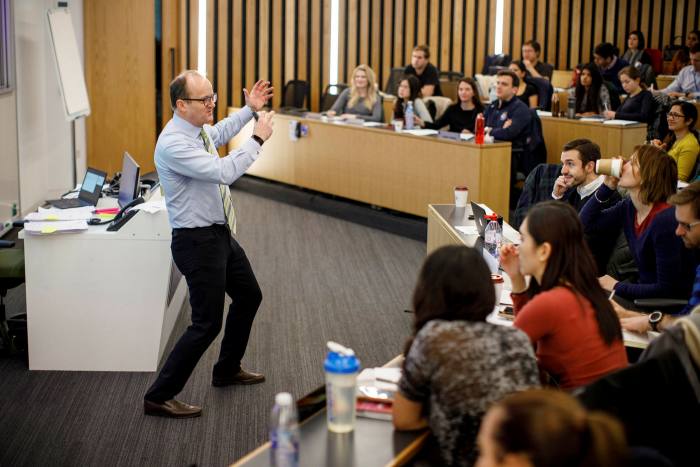FT Masters in Management ranking 2021: methodology and key
Methodology
This is the 17th version of the FT rating of Masters in Administration (MiM) programmes.
A document 124 MiM programmes took section in the rating method in 2021, up from 114 in 2020. Faculties need to satisfy rigorous criteria in order to be qualified. Their programmes need to be entire-time, cohort-based and colleges need to be accredited by either AACSB or Equis. Classes need to be directed at learners with minimal or no work encounter. The rating covers typical management programmes, not specialised ones.
The table is calculated in accordance to information and facts gathered by two individual surveys. The first is accomplished by the organization colleges and the 2nd by alumni who concluded their MiM in 2018.
The FT usually requires a reaction amount of twenty for every cent of alumni, with a bare minimum of twenty responses, for a faculty to enter the rating calculations. Due to the pandemic, the FT deemed colleges with a lessen reaction amount. Some 7,four hundred alumni accomplished this year’s survey — a reaction amount of about 29 for every cent.
FT Masters in Administration rating 2021 — leading 100

Obtain out which colleges are in our rating of Masters in Administration degrees. Study how the table was compiled and go through the relaxation of our coverage at www.ft.com/mim.
The rating has seventeen criteria. Alumni responses advise 7 criteria that jointly add fifty eight details of the ranking’s overall fat. The remaining ten criteria are calculated from faculty facts and account for 38 details of the fat.
For this 12 months, the overall fat for the table is 96 details. Due to the journey limitations brought about by the pandemic, the fat for the international course encounter class has been reduced. This steps students’ abroad exposure in the course of their degree.
The recent average income of alumni has the greatest weighting, at twenty details. Area salaries are transformed to US dollars applying getting ability parity premiums (PPP) supplied by the IMF. The salaries of non-financial gain and community services workers, and entire-time learners, are eradicated. Salaries are normalised by eliminating the pretty greatest and cheapest salaries noted.
Income enhance is the 2nd most significant criterion, with a weighting of ten details. It is based on the average change in alumni income among their first MiM-level task just after completion and their recent income, three years just after completion. Fifty percent of the fat is applied to the complete income enhance and the other 50 % is applied to the relative proportion enhance.
In which offered, information and facts gathered about the earlier three years is employed for alumni criteria. Responses from 2021 have fifty for every cent of the overall fat and all those from 2020 and 2019 each account for 25 for every cent. Excluding income-connected criteria, if only two years of facts are offered, the weighting is break up 60:40 if facts are from 2021 and 2020, or 70:30 if from 2021 and 2019. For income figures, the weighting is fifty:fifty for two years’ facts, to negate inflation-connected distortions.
Data delivered by colleges are employed to measure the variety of instructing staff, board associates and learners in accordance to gender and nationality and the international access of the programme. For gender criteria, colleges with a fifty:fifty (male: feminine) composition acquire the greatest rating.
When calculating international variety, in addition to the proportion of international learners and college at a faculty — the figures posted — the FT also considers the proportion of international learners and college by citizenship.
A rating is then calculated for each faculty. First, Z-scores — formulas that replicate the variety of scores among the leading and base faculty — are calculated for each rating criterion. These scores are then weighted and included jointly to give a remaining rating. Faculties are rated in accordance to these scores, generating the FT Masters in Administration rating of 2021.
Just after discounting the colleges that did not satisfy the reaction amount threshold from the alumni survey, a first version is calculated applying all remaining colleges. The faculty at the base is eradicated and a 2nd version is calculated, and so on till the remaining rating is attained.
Other information and facts in the table — programme size, the number of learners enrolled, general fulfillment and the proportion of learners who undertake internships — does not add toward the rating. (See the vital to the rating under.)
Judith Pizer of Pizer-MacMillan acted as the FT’s databases specialist.
Key: weights for rating criteria are revealed in brackets as details.
The overall table fat adds up to 96 details.
Income these days US$: average income three years just after completion (not employed in the rating calculation), US$ PPP equivalent (getting ability parity. See methodology at ft.com/mim-approach) †*
Weighted income US$ (twenty): average graduate income three years just after completion, adjustment for income variants among sectors, US$ PPP equivalent. †*
Income enhance (ten): average change in alumni income among completion and these days. Fifty percent of this figure is calculated in accordance to the complete enhance and 50 % in accordance to the relative proportion enhance. †*
Benefit for dollars (five): calculated in accordance to alumni salaries these days, expenses and other prices. †*
Profession progress (five): calculated in accordance to improvements in the level of seniority and the size of enterprise alumni are performing for among completion and today. †*
Aims attained (five): the extent to which alumni fulfilled their targets for performing a masters. †*
Professions services rank (five): efficiency of the occupations services in supporting scholar recruitment, rated by alumni. †*
Used at three months % (five): proportion of the most latest finishing class that found employment within just three months of finishing their course. Figure in brackets is the proportion of the class for which the faculty was ready to give facts. §
Female college % (five): proportion of feminine college as of April one. ‡
Female learners % (five): proportion of gals on the masters programme on March 31. ‡
Females on board % (one): proportion of gals on the faculty advisory board. ‡
Worldwide college % (five): calculated in accordance to the variety of college (on April 1) by citizenship and the proportion whose citizenship differs from their region of employment — the figure posted in the table.
Worldwide learners % (five): calculated in accordance to the variety of recent MiM learners by citizenship and the proportion whose citizenship differs from the region in which they research — the figure in the table.
Worldwide board % (one): proportion of the board whose citizenship differed from the school’s home country.
Worldwide mobility (8): calculated in accordance to improvements in the region of employment of alumni among completion and these days. Alumni citizenship is taken into account. †*
Worldwide course encounter (4): calculated in accordance to whether the most latest finishing masters class carried out exchanges and enterprise internships, lasting at least a thirty day period, in nations around the world other than the place the faculty is based. Digital encounters are not incorporated. An average calculation was taken from the 2021 survey and the earlier two years’ international course encounter facts (2020 and 2019), if offered. For colleges that have taken section for the first time this 12 months, only facts from the 2021 survey were being employed. Due to journey limitations brought about by the pandemic, some colleges were being not able to give latest facts for this class. If you are a possible scholar, remember to contact the faculty to test if they give research excursions and internships abroad. †§
Extra languages (one): the number of languages necessary on graduation, excluding English.
Faculty with doctorates % (6): proportion of college with doctoral degrees at April one.
The classes under are for information and facts only and are not employed in the ranking calculations.
Normal course size (months): average size of the masters programme.
Variety enrolled 2020-21: number of learners who enrolled in the first 12 months of the masters programme in the earlier 12 months.
Over-all fulfillment: average evaluation by alumni of the masters course, scored out of ten. Just after alumni answered different queries
about their masters encounter, which include the high quality of the school’s occupations services, they were being questioned to amount their general fulfillment, on a ten-level scale.
Business internships (%): the proportion of the final finishing class that undertook internships as section of the programme. §
† Contains facts for the recent and just one or two previous years the place offered.
‡ For all gender-connected criteria, colleges with a fifty:fifty (male/feminine) composition acquire the greatest rating.
* Data from alumni who accomplished their programmes in 2018 incorporated.
§ Completed MiM among March one, 2020 and February 28, 2021.







